What to see in Barcelona? How to start, how to manage everything and how not to get lost in this huge beautiful city?
Contents
- Where to start? Plaza Catalunya
- The main street of Barcelona Rambla
- The Gothic Quarter of Barcelona
- Santa Maria del Pi
- The New Square( Placa Nova)
- St. Felipe Neri Square
- The King's Square( Placa del Rei)
- Placa Sant Jaume
- Museumwax figures of
- Old port and Barceloneta
- Football stadium Camp Nou
- Eixample district
- Famous houses of Barcelona on Passeig de Gracia avenue
- Sagrada Familia
- Park Güell
- Catalan music palace
- Bellesguard tower
- Tibidabo Park
- Fortress and Montjuic Mountain
- Plaza of Spain and Singing Fountains
- Barcelona Zoo
- Barcelona Neighborhood
- Colonia Güell
- Montserrat Monastery
- The main attractions of Barcelona: how to catch everything?
- Video: All of Barcelona in 3 minutes
- Video: Montserrat Caballe and Freddie Mercury. Barcelona
- Video: Barcelona city official promo
- Video: Montserrat: Ave Maria( official video)
Where to start? Plaza Catalunya
If you do not know where to start an inspection of Barcelona, feel free to go to Plaza Catalunya( Placa de Catalunya).In the architectural and historical sense, the square of Catalonia is not the most outstanding place in Barcelona. But it can rightly be considered the main square of the capital of Catalonia.

This is where the most popular tourist routes begin, from the square the most famous historical streets diverge, there are the largest number of shops and souvenir shops, frequent buses come here, and Passeig de Gracia station is not far away.

Formerly, Plaza Catalunya was remarkable by the huge flocks of tame pigeons that flocked here to feed from all over Barcelona. But recently the City Hall of Barcelona has considered that pigeons too spoil the aesthetic appearance of the architectural ensemble of the square, besides they are unsafe for people's health, so recently there have not been enough pigeons on the square.

The main street of Barcelona Rambla
Rambla( Rambla) is the most famous street in Barcelona. It stretches from Plaza Catalunya to the Columbus Monument. The street is a pedestrian zone, along which there are many souvenir shops, flower shops and cafes. In the evenings, there are many street artists, musicians and artists.

In the Middle Ages, Rambla was a shopping street adjoining a city where residents of the surrounding villages traded. Rambla consists of five sections, each of which has its own history and attractions.

The site closest to the Plaça Catalunya is called Rambla Canaletes( Gulf of Gutters) , and is remarkable for the fact that the old fountain with drinking water is preserved here. He enjoys great success with tourists. On the fountain there is a sign promising to all who try this water, eternal love for Barcelona and an indispensable repeat trip here.

This is followed by Rambla dels Estudis( Study Boulevard) .In the Middle Ages there was a local university, which in the XVIII century was moved to another place, and the name was fixed behind the boulevard. Now on the boulevard there is a functioning church and the theater "Polyorama", which is a world-class stage.

Rambla de les Flors is famous for its famous Boqueria market, which has existed since the XIII century - the main market of Barcelona, worthy of a separate excursion. The market is named after the old city gate of Bokeria, near which the main fair of medieval Barcelona unfolded.
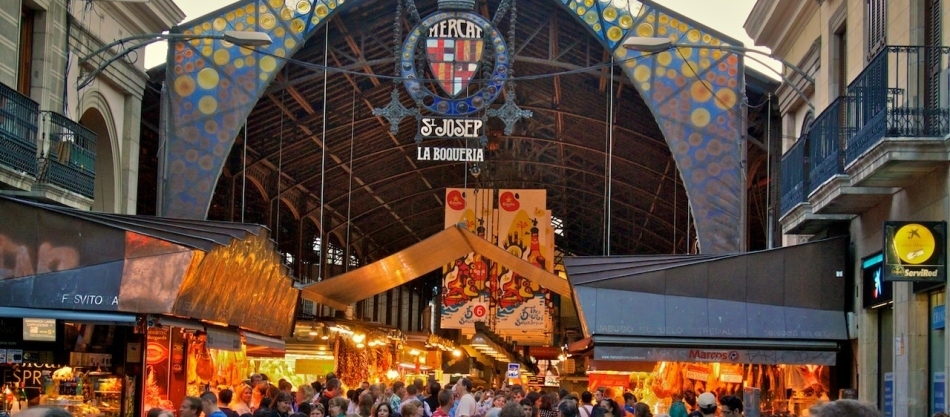
Next site - Rambla dels Caputxins - named after the monastic order of the Franciscan branch. On this stretch you will find the Grand Theater of Liceu, which often features opera singers and world-class symphony groups. Also here is the oldest in Spain theater "Principe", in which you can listen to a concert of chamber music or watch performances by local artists.

Rambla de Santa Mònica is the last part of the medieval Rambla, adjacent to the Plaza de la Pau( Gate of Peace), on which stands the Columbus monument. It was on this square that the kings of Aragon accepted Columbus after the first legendary discovery of America.

The Gothic Quarter of Barcelona
This is the oldest part of Barcelona. Within the boundaries of the Gothic quarter, Barcelona has evolved since its inception in the I century BC up to the year 1860.All this time, the townspeople were officially forbidden to build houses outside the fortress wall, and in the old borders everything was built up in the Middle Ages, so the architecture of the Gothic quarter is so different from the surrounding areas.
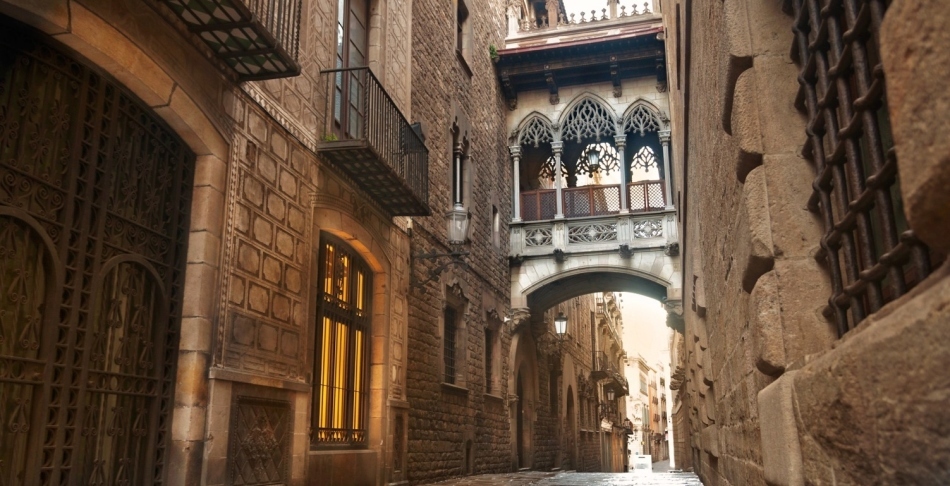
Here people of medium and low incomes live, in some parts of the block it is not necessary to appear at night, and the main attractions are concentrated within 3-4 streets in the center of the district.
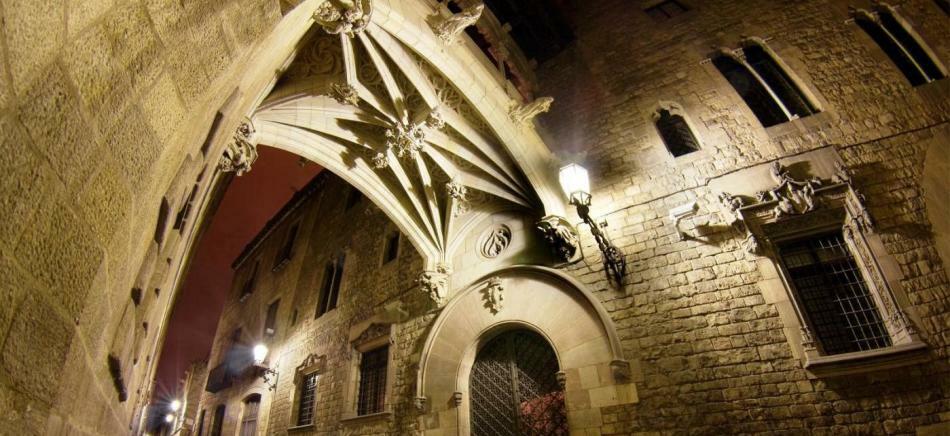
What is worth seeing in the Gothic Quarter?
Santa Maria del Pi
Church of Santa Maria del Pi( Iglesia de Santa María del Pí). It is fairly easy to find if you go to the Gothic Quarter on the street Carrer del Cardenal Casanas( it starts near the "house of umbrellas"opposite the exit from the metro station Liceu).
 House of umbrellas on Rambla, Barcelona, Spain
House of umbrellas on Rambla, Barcelona, Spain This is a typical early medieval temple, although it was rebuilt several times because of injuries sustained during wars and earthquakes
 Church of Santa Maria del Pi( Iglesia de Santa María del Pí), Barcelona
Church of Santa Maria del Pi( Iglesia de Santa María del Pí), Barcelona The new area( Placa Nova)
Next point is The new area( Placa Nova) .From the church to it leads the street Carre de la Palla. Placa Nova is the main square of old Barcelona. The new square was named back in 1358, when the residents started building around the ancient Roman settlement of Barsino.
 New Placa( Placa Nova), Barcelona
New Placa( Placa Nova), Barcelona Placa Nova housed the central market of medieval Barcelona, where everything was sold, including slaves. The plaza of Nueva is remarkable because in a small area, different historical epochs literally grew into each other.
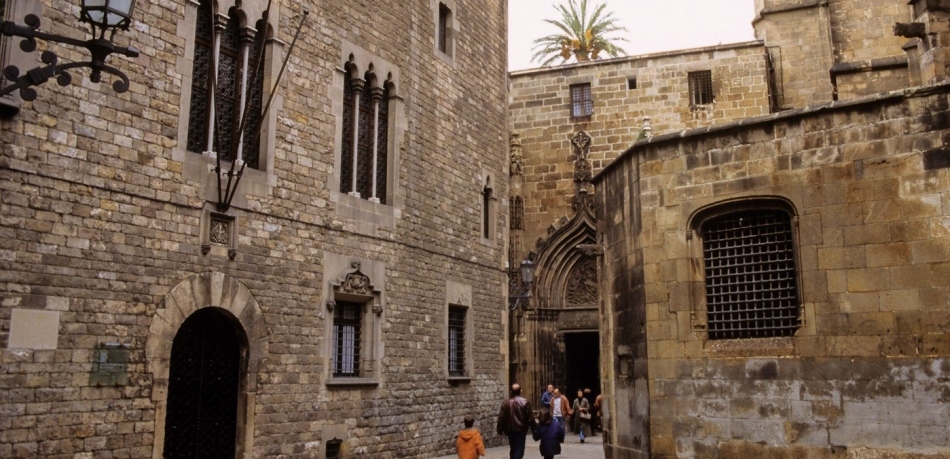
Here you can see the remains of the Roman fortress towers - the northern gate of Barsino and a fragment of the aqueduct, along which water was supplied to the city. The House of the Archdeacon( Casa de l'Ardiaca) is very interesting - behind the outwardly unremarkable wall lies a patio that impresses with its beauty and an abundance of interesting historical details.
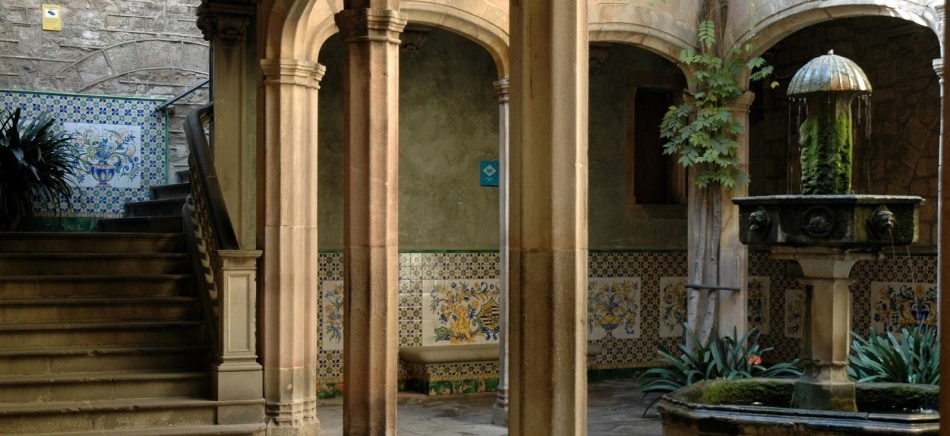 Casa de l'Ardiaca, Gothic Quarter, Barcelona
Casa de l'Ardiaca, Gothic Quarter, Barcelona Here at Pla de la Seu is the main Catholic Church of Barcelona - Cathedral of the Holy Cross and St. Eulalia ,It was named after a 14-year-old local Christian girl, martyred at the hands of the Romans at the time of Barsino.
 Cathedral of the Holy Cross and Saint Eulalia
Cathedral of the Holy Cross and Saint Eulalia St. Felipe Neri square
Another interesting place nearby is St. Pléça de Sant Felip Neri square .It is easy to find, if you move from the New Square along the street Carrer del Bisbe( the street starts right between the two old Roman towers).
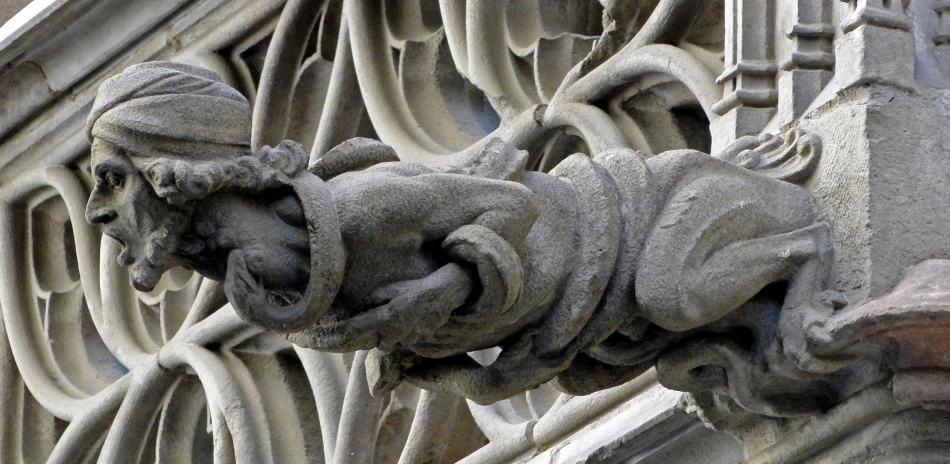
Meters in 50 will be a small area of the heroes of the war of 1811.On the square you need to turn right into the alley Carrer de Montjuic del Bisbe, which will take you to the square of Felipe Neri. This is a typical medieval square, untouched by time. Here is a very interesting museum of medieval shoes.
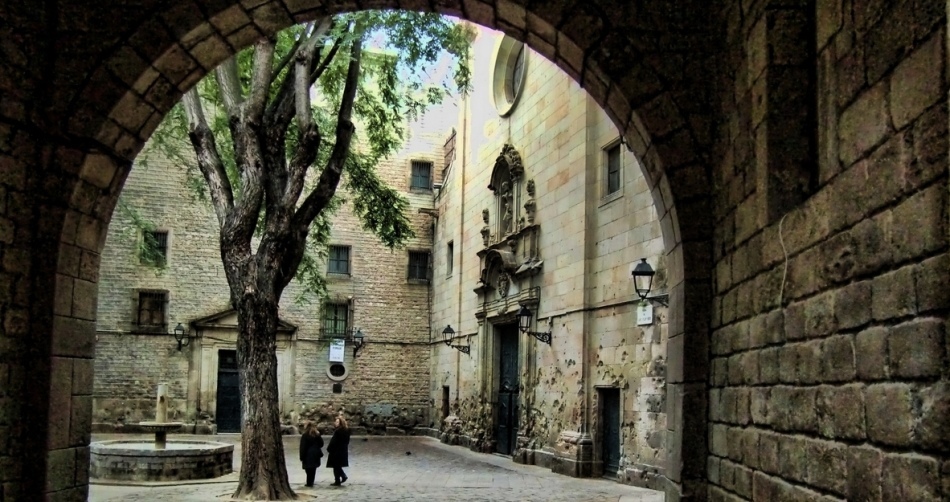 Plaça de Sant Felip Neri, Barcelona
Plaça de Sant Felip Neri, Barcelona The King's Square( Placa del Rei)
It's worth to look at the Placa del Rei , where the residence of the kings of Aragon is located( Catalonia and the adjacent regions of Spain and France in 1035-1707). Many localsconsider the area of the King as one of the most beautiful places of the Gothic quarter. The area is easy to find if you walk along the street Carrer dels Comtes from the main entrance to the Cathedral of St. Eulalia( the street starts to the left of the main entrance) to its end and turn left.
 Placa del Rei, Barcelona
Placa del Rei, Barcelona Placa Sant Jaume
Not far from the King's Square there is another ancient square - St. Jacob's Square .It was the center of the ancient Roman city of Barcelo, here was the Forum and the residence of the Roman governor. Now in the square are the City Hall of Barcelona and the Palace of the Government of Catalonia. From St. James Square you can return to Rambla along Carrer de Ferran.
 Placa Sant Jaume, Barcelona
Placa Sant Jaume, Barcelona Barcelona Wax Museum
The Museu de Cera is not only a wax copy of the famous characters of modern times and recent history. The exposition of the museum has unique installations, recreating the way of life and appearance of the inhabitants of the past epochs - from the Cro-Magnon people to our days.

The team of the most serious historians worked on the exposition of the museum, so all details to the smallest detail exactly correspond to historical documents. The museum also has a camera of medieval torture, a bank branch of the 1930s, a gallery of the greatest criminals of history and fictional characters from mermaids to the master of Yoda from the star wars.

The museum has a very unusual cafe, the interiors of which recreate a real fairy forest, and foliage, birdsong and very realistic figures of gnomes and mermaids make the place simply fantastic.
The museum is located at the end of the Rambla of Saint Monica at Passadge de la Blanca 7

The Old Port and Barceloneta
The old port begins with the of the Portal de la Pau of the , on which the Christopher Columbus monument is erected, and the old port buildingexchange. On this square the rulers and the nobility of Aragon met the seaman with triumph after the discovery of the New World.
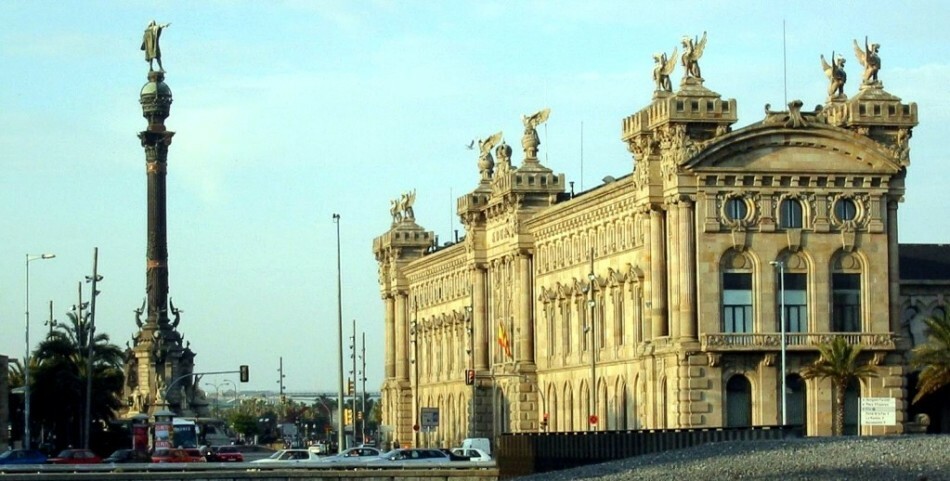 Area of the Portal de la Pau, Barcelona
Area of the Portal de la Pau, Barcelona Port Vell( Old Port ) is the area between the Columbus statue and the small fishing area of Barceloneta. Drassanes is the nearest metro station to the Port Wel district. From Rambla to the Old Port, there is a small bridge of unusual curved shape Rambla del Mar .
 Rambla del Mar, Old Port, Barcelona
Rambla del Mar, Old Port, Barcelona The main tourist sites of the Old Port - shopping mall Maremagnum and The Barcelona Aquarium( Barcelona) The is one of Europe's largest aquariums, which displays all water aquariumsecosystems of the planet - from the Arctic to the equatorial latitudes.
 Barcelona Aquarium( L'Aquàrium de Barcelona)
Barcelona Aquarium( L'Aquàrium de Barcelona) The Maremagnum is a comfortable place to relax after a walk through the Rambla, there are many small cafes and restaurants for every taste, there is a McDonald's, a children's play area inside the complex, an IMAX cinema.
 Maremagnum, Barcelona
Maremagnum, Barcelona Barceloneta is a very beautiful and quiet residential area, popular with tourists in the summer. There are many students and young families living in Barceloneta. The most popular mode of transport here is bicycles, which you can rent on the street.
 Barceloneta, Barcelona
Barceloneta, Barcelona Here you should visit the Museum of Catalan History, which has unique interactive exhibits of the Middle Ages: you can crush grain in an old wooden mortar or go into the preparation of skins. Also in Barceloneta, there are excellent beaches and embankments, in the summer it is quite crowded.
 Beaches of Barceloneta
Beaches of Barceloneta From the tower of San Sebastian( San Sebastian) you can take a cable car to Mount Montjuïc( Telefèric de Montjuïc).From the cockpit of the funicular there are absolutely stunning views of the city and the Old Port.
 Funicular on Mount Montjuïc
Funicular on Mount Montjuïc Football stadium Camp Nou
Football fans should not bypass visiting the football stadium Camp Nou. This is one of the most grandiose stadiums in Europe and the home ground of the football team "Barcelona".Here is the museum of FC Barcelona, one of the most visited museums in Barcelona. The closest metro stations to the stadium are: Palau Reial and Badal
 Camp Nou Stadium
Camp Nou Stadium Eixample district
L'Eixample district The is primarily famous for its architecture. This is a residential area, the construction of which began only 150 years ago, when the Barcelona authorities finally decided to demolish the old city walls and allow citizens to build houses outside the Gothic Quarter( the old borders of Barcelona).
 Echample Area( L'Eixample)
Echample Area( L'Eixample) Eixample is a real exhibition of vanity of the rich citizens of the XIX century. After the stuffy and cramped streets of the Gothic quarter, wealthy families of Barcelona finally got the opportunity to realize all their architectural fantasies and quirks. Often the construction of the house was spent fabulous sums, the best architects were hired, and materials for finishing were brought from all over the world. The main street of the district is Avenue Passeig de Gracia
 Passeig de Gracia
Passeig de Gracia Famous houses of Barcelona on Passeig de Gracia Avenue
Casa Lleó Morera in Art Nouveau style in Quarter Nesoglossia near Plaça Catalunya, st.m. Passeig de Gracia. The building is privately owned, so the view is only possible from the outside.
 Casa Lleó Morera
Casa Lleó Morera Casa Amatller is located across the building from the House of Morera. The decoration of the Amalier House is made in Moorish motives, which gives it a very unusual look. From the inside, the house of Amalier can be inspected in the redistribution of the lower two floors.
 Casa Amatller
Casa Amatller Neighboring building - Casa Batlló - the creation of the great Gaudí.Casa Batllo in the common people is called "house on the bones" because of the bizarre shape of the columns and balconies of the building. In addition to unusual lines, the façade of the building is decorated with the signature reception of the Grand Master - a multicolored mosaic. The Casa Batlló is available for inspection from the inside, where the decoration of the rooms and the shape of the walls strike no less than the outside of the building.
 Casa Batlló
Casa Batlló Three blocks from Casa Batlló is another famous house built by Antonio Gaudi - Casa Mila .Barcelona's fir-trees for appearance are called Pedrera( La Pedrera), which means "quarry".This is perhaps the most unusual house in Barcelona, in which a lot of brilliant ideas are collected, such as moving walls, allowing to change the internal layout of rooms.
 Casa Mila( Casa Mila)
Casa Mila( Casa Mila) Even chimneys and elevator shafts on the roof are made in the form of sculptural figures. Partly the Mil House is accessible for tourists. The nearest metro station to the Mil House is Diagonal.
 Casa Mila
Casa Mila Another well-known house is located somewhat away from Passeig de Gracia, just one metro stop from Mila's House. Casa Vicens was built by Gaudi at the request of the well-known industrialist of Barcelona Manuel Vissens. The house is located near the metro station Fontana.
 Casa Vicens
Casa Vicens Sagrada Familia
The Sagrada Família Temple - the Sagrada Familia - is the most famous creation of Antoni Gaudi. The Sagrada Familia was conceived as an architectural embodiment of the Gospel. The construction was very slow, as the temple was built solely on donations from the townspeople.
 Sagrada Família
Sagrada Família During Antonio Gaudi's lifetime, only the facade of Christmas was completed from the four facades of the church. The rest of the facades were designed and built by other well-known architects. The final completion of the construction is planned by 2026.
 Facade of the Nativity, Sagrada Família
Facade of the Nativity, Sagrada Família Park Güell
Park Güell( Parque Güell) - the business card of Barcelona. Initially, the park was conceived as a residential park area for wealthy citizens. However, the site allocated for the construction of cottages, was, according to the citizens, too far from the center. In addition, it was located on a fairly hilly terrain, which also seemed not too convenient.
 Parque Güell
Parque Güell As a result, the creation of Gaudi was just a park.
In the park there are many walking alleys and roads, which are equipped with signs and plaques with descriptions of attractions.
 Parque Güell
Parque Güell From the top terrace of the park you can see a stunning panorama of the city against the background of the sea. The decoration of the park amazes with an abundance of unusual details and forms, which sometimes make a walk through the park simply fabulous.
 Parque Güell
Parque Güell The Palace of Catalan Music
The Palace of Catalan Music( Palau de la Música Catalana) is a majestic building in the Arab-Spanish style. Even if you are not a big fan of classical music, it's worthwhile to come here at the station. Urquinaona, to personally see all the splendor of Catalan architecture of the early XIX century. The interior decoration of the palace will also impress with its splendor.
 The Palace of Catalan Music( Palau de la Música Catalana)
The Palace of Catalan Music( Palau de la Música Catalana) The Belgesguard Tower
The Torres Bellesguard Tower is another amazing creation by Antoni Gaudi. From the usual order for the construction of a country residence for one of the Catalan families, Antoni Gaudi created a real medieval tower, worthy of the most demanding aristocrats. The Belvesguard Tower is a 15-minute walk from the Av. Tibidabo Metro Station.
 Torre Bellesguard, Tibidabo
Torre Bellesguard, Tibidabo Tibidabo Park
The most picturesque way to get to the top of Tibidabo Mountain( Tibidabo), where the park is located is the oldest tram line in Barcelona, the Tramvia Blau .Blue trams of the beginning of the 20th century run along it, the route runs through a very picturesque residential area of the Catalan aristocracy, so the road to Tibidabo can be considered a separate adventure.
 Tramvia Blau
Tramvia Blau The Tramvia Blau stop is located close to the Av. Tibidabo metro station. On the tram you need to reach the terminal station, from which the same old and authentic funicular goes to the top of the mountain.
 Tibidabo Luna Park, Barcelona
Tibidabo Luna Park, Barcelona Tibidabo Park is the oldest amusement park in Europe. Some of the attractions have retained their authentic look, they can still be ridden, for example a real plywood airplane of the early 20th century or the carousel of our great-great-grandmothers. In the park there are also modern attractions, but the entrance to this park zone is paid.
 Amusement park amusement park Tibidabo, Barcelona
Amusement park amusement park Tibidabo, Barcelona The Museum of mechanical toys of the beginning of the last century( Museo automatas Tibidabo ), whose exhibits will surprise both children and adults, also deserves attention. Walt Disney has long persuaded the owners of the park to sell him the exhibits of this museum, but was refused.
 Museum of the mechanical toy( Museo automatas Tibidabo)
Museum of the mechanical toy( Museo automatas Tibidabo) At the top of Tibidabo, the Temple Expiatori del Sagrat Cor( ) was built. The dome of the church is crowned with a statue of Christ embracing the world( a copy of this statue of incredible dimensions is set in Rio de Janeiro and is the visiting card of the city).The temple is visible from anywhere in Barcelona, so to Tibidabo - the highest mountain in the city.
 Temple Expiatori del Sagrat Cor
Temple Expiatori del Sagrat Cor Fortress and Mount Montjuic
Fortress Montjuic( Castell de Montjuïc) is located on the top of the mountain of the same name, with a very beautiful view of the city's water harbor. In the XVII-XIX centuries the fortress was used as a defensive structure. During the Franco regime in the 1940s and 1960s, it was used as a prison for especially dangerous criminals and political prisoners.
 Fortress Montjuïc( Castell de Montjuïc)
Fortress Montjuïc( Castell de Montjuïc) Currently, the military museum is opened in the fortress, in which weapons from different eras and countries of the world are represented. In addition to the fortress on Mount Montjuik are various objects of the 1992 Olympics and the World Exhibition of 1929, as well as several parks. To get to the top of the mountain you can on the cable car from Barceloneta or from the Plaza of Spain, which is located at the foot of the mountain.
 Montjuïc( Montjuïc), Barcelona
Montjuïc( Montjuïc), Barcelona Plaza of Spain and singing fountains
Plaza of Spain( Plaça d'Espanya) The is perhaps the biggest square in Barcelona. Through it passes as many as three branches of the metro, intersects 5 streets, here are the final stops of sightseeing routes and aero-express. Here is the Arena of Barcelona( shopping center, the former site of the corrida), many restaurants, large and small shops, in the center of the square is a large fountain.
 Plaza of Spain( Plaça d'Espanya), Barcelona
Plaza of Spain( Plaça d'Espanya), Barcelona One of the main attractions near the Plaza de España - The National Art Museum of Catalonia( MNAC) .Here you can find samples of ancient coinage, medals from different eras, unique examples of medieval church art collected from the Catholic churches of the whole region, samples of wall romance painting and art paintings of various directions from the 11th to the 19th centuries.
 Museum of National Art of Catalonia( MNAC)
Museum of National Art of Catalonia( MNAC) Opposite to the Museum of National Art is the famous singing fountain of Barcelona .It would be open to the beginning of the World Trade Exhibition in 1929 and so impressed the first visitors that from those years the floor was nicknamed the "Magic Fountain".
 Singing fountain, Barcelona
Singing fountain, Barcelona The show of singing fountains begins at dusk. In addition to classical works, modern hits also serve as accompaniment for the fountain. The show ends with the unchanged performance of the anthem of Barcelona in the performance of Freddie Mercury and Montserrat Caballe.
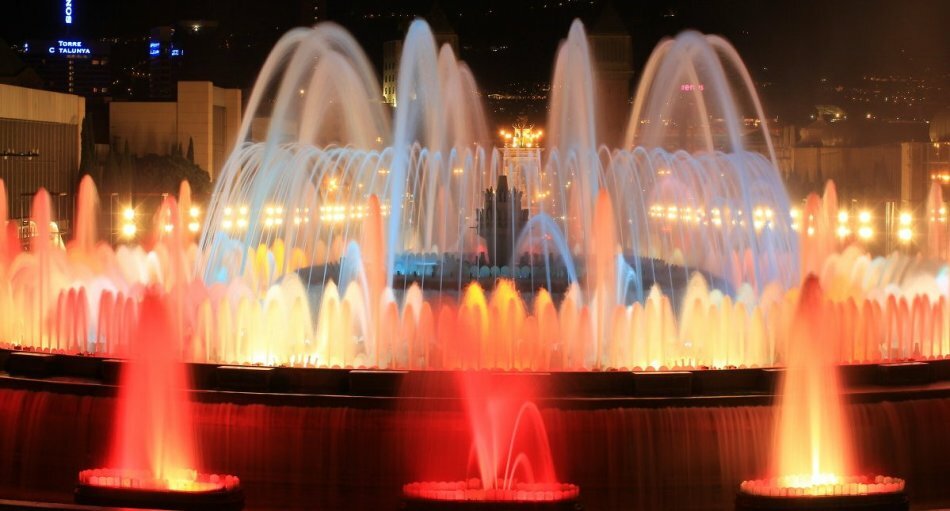 Singing Fountain Show, Barcelona
Singing Fountain Show, Barcelona Spanish Village( Poble Espanyol) is another building built for the 1929 World Trade Fair. It is a complex of 117 exact copies of historical buildings from different cities of Spain. In addition to Spanish architecture, you can try yourself as a medieval artisan on one of the village streets: pottery, glass blowing workshop, and others.
 Spanish Village( Poble Espanyol), Barcelona
Spanish Village( Poble Espanyol), Barcelona Barcelona Zoo
Barcelona Zoo( ZOO Barcelona) is located near Barceloneta in the Ciutadella metro station area |Vila Olímpica. In the collection of the zoo more than 7,5 thousand species of animals, including:
 Zoo Barcelona
Zoo Barcelona - Large group of primates from gorillas to dwarf mangabeys
- Bottle-bearing dolphins
- Elephants, giraffes, hippos family, rhino
- Hyenas, buffaloes, all kindslarge cats from tigers to snow leopards
- Rare birds, including gray herons and pink flamingos
 ZOO Barcelona
ZOO Barcelona - A terrarium with a large collection of reptiles, including rare species of crocodiles and poisonous lizards
- There is a huge syu in the parkatranskaya Tortoise, Meerkat family and kangaroo
- a large outdoor aviary with the penguins, the main attraction in which - feeding penguins fish
- There are play areas angering the little ones, a dolphinarium with daily shows, a few cafes and restaurants. On the territory of the zoo for the convenience of movement a small locomotive drives.
 Barcelona ZOO Barcelona
Barcelona ZOO Barcelona Barcelona's surroundings
Colonia Güell
The Colonia Güell was conceived as a settlement for local factory workers at the end of the 19th century. It was a whole town with houses for workers, a school, a shop, a church, its own theater and a hospital.
 Colonia Güell
Colonia Güell Since the construction was attended by eminent architects of the time, and the owner of the construction site was the wealthy industrialist of Barcelona Eusebio Güell, who spared no money for construction, the colony turned out to be not just a working village, but a complete architectural monument. Now in the territory of the colony there is a protected monument-museum, which allows to see the characteristic life of workers' settlements of the era of industrialization.
 Colonia Güell
Colonia Güell Montserrat Monastery
Montserrat Monastery is an active Franciscan monastery, which is located in the national park of Catalonia, on top of the mountain of the same name. It houses the famous statue of the Black Madonna( Madonna Nero), attracting pilgrims and tourists from all over the world.
 Montserrat
Montserrat The first mention of the monastic settlement at this place dates back to the year 880.In the XII century, the stone buildings of the monastery, existing to this day, were rebuilt. Until now, only a part of the buildings survived, so the monastery suffered greatly during the war with Napoleon.
 Monastery Montserrat
Monastery Montserrat The school for boys Escolania de Montserrat was opened at the monastery from the XIII century, the training in which is still considered very prestigious for local wealthy families. Every day( except during the school holidays) at 13:00 the boys' choir of the school performs at the local cathedral during the day's mass. Places you need to borrow for 30-40 minutes, as to listen to this choir is going to so many people that before the beginning of Mass in the temple, literally there is nowhere to fall an apple.
 Choir Escolania de Montserrat, Montserrat
Choir Escolania de Montserrat, Montserrat The Black Madonna is considered a wonder-working statue. The queue to it stretches for many hundreds of meters. It is believed that it fulfills the wishes of anyone who touches it, if the request comes from a pure heart and does not contain bad intent. At the monastery there is a special room where believers bring evidence of fulfillment of desires - photos of newborns, wedding dresses, unnecessary crutches and much more. Judging by the abundance of the collection in this room, the wishes are really being fulfilled, so do not miss your chance.
 Miraculous statue of the Black Madonna( Madonna Nero), Montserrat
Miraculous statue of the Black Madonna( Madonna Nero), Montserrat You can get to the monastery from the Plaza of Spain. There is a special tourist train Monserrat Express. The train delivers tourists not to the monastery itself, but to the lower point of the Montserrat mountain, where it is necessary to transfer to a special mountain gear train that goes to the very top of the mountain. The fare on the train is already included in the ticket price for Monserrat Express.

The main attractions of Barcelona: how to catch everything?
In order not to get lost in the many sights of Barcelona and not to waste time traveling from one end of the city to another, we suggest grouping the excursions as follows:
- Plaza Catalunya + Rambla + Gothic Quarter + Wax Museum
- Old Port + Aquarium + Barceloneta + Barcelona Zoo
- Mount Montjuic + Museum of Catalan National Art + Spanish Village + singing fountains + Plaza of Spain
- Plaza Catalunya + Passeig de Gracia + famous Gaudí houses( Leo Morera's house, Amillera's house, Casa Batllo, then Mila's house) + Vicens house + Sagrada Familia + Eixample district
- Bellesguard tower + Tibidabo park and Sacred Heart temple
- Gaudi park

In this order you can view the sights of each group for the day, as they are located inwalking distance, or at a distance of 1-2 metro stops from each other.
Read more about Barcelona transport here
